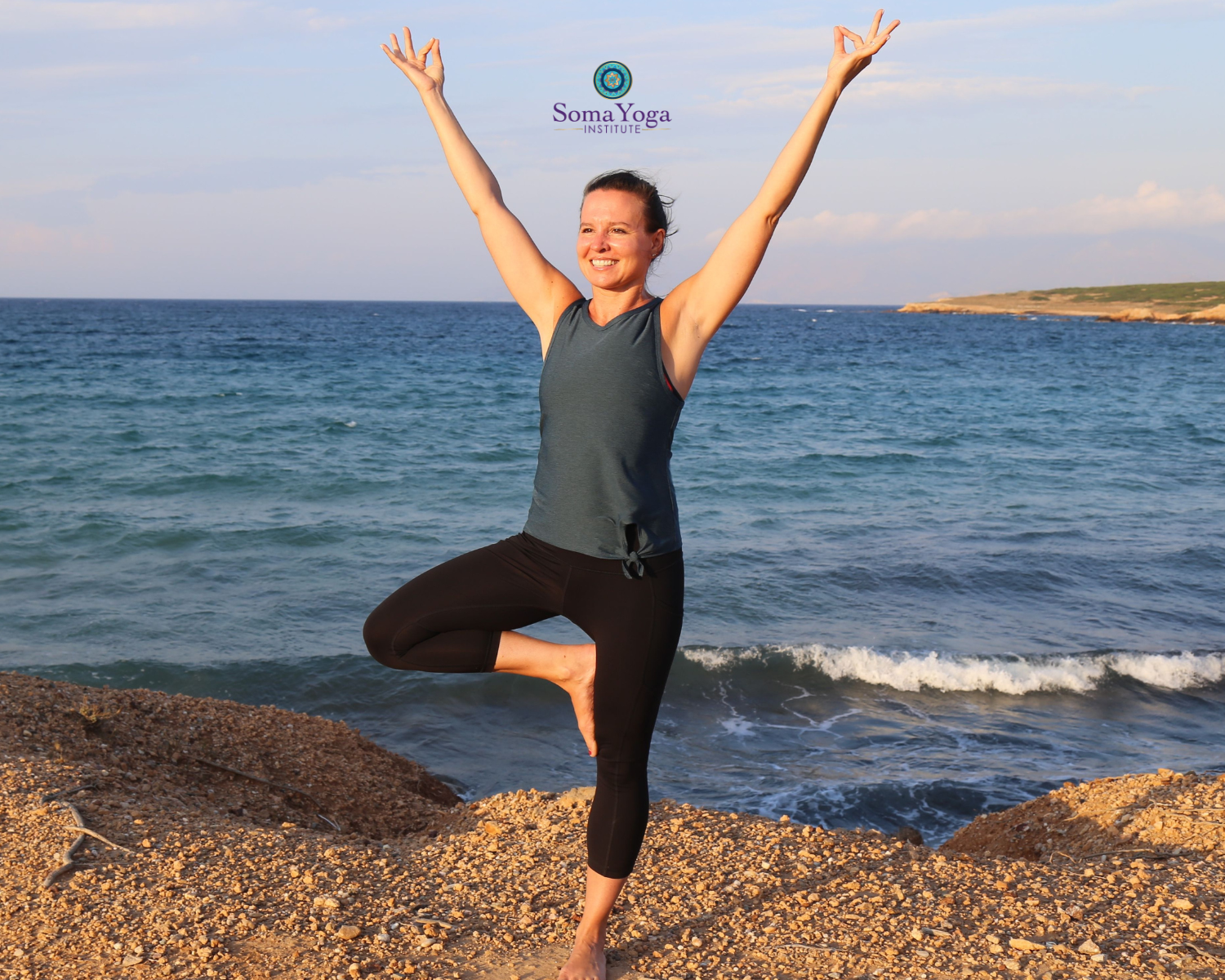Updated: 10/5/24
Introduction
Yoga teacher training is a transformative journey that allows you to delve deep into the ancient practice of yoga and emerge as a certified instructor. While the ultimate goal remains the same, the path to becoming a yoga instructor can take different routes. One of the critical decisions you’ll need to make is whether to pursue your yoga teacher training online or in person.
In this blog, we’ll explore the pros and cons of both approaches to help you make an informed choice when finding the best yoga teacher training for you.
But first, lets start with the basics…

Reasons to Pursue Yoga Teacher Training
As we delve deeper into the world of yoga teacher training courses, it’s essential to explore the reasons why so many individuals decide to embark on this transformative journey. Yoga training is not just about earning a certification or learning to guide a yoga class; it’s a profound exploration of self, a commitment to the practice, and a gateway to a world of holistic well-being and self-discovery.
In this section, we’ll highlight the compelling reasons that motivate people to pursue a yoga teacher training course. Whether you’re contemplating taking this path or are simply curious about the motivations of aspiring registered yoga teachers, read on to discover the diverse and inspirational reasons that lead individuals to embrace the transformative journey of yoga teacher training.
Yoga teacher training is a transformative journey that goes well beyond learning to instruct asanas or guide a class through a sequence. It’s a deep dive into the philosophy, principles, and practice of yoga, offering a wealth of personal and professional benefits.
If you’re contemplating whether to embark on a 200-hour yoga teacher training, consider the following compelling reasons that might inspire you to take the leap:
Deepen Your Personal Practice
A yoga teacher training program provides an opportunity to immerse yourself in the practice of yoga like never before. You’ll develop a profound understanding of asanas, meditation, and pranayama, enriching your own practice and spiritual connection.
Expand Your Knowledge
Yoga teacher training is a journey of self-discovery and learning. Prospective registered yoga teachers delve into the yoga history and yoga philosophy, exploring ancient texts such as the yoga sutras and gaining insight into the rich tradition that underpins this practice. Yoga teacher training programs may also explore various yoga styles such as yin yoga, ashtanga yoga, hatha yoga, yoga nidra, etc.
Strengthen Physical and Mental Health
The regular practice of yoga has numerous physical and mental health benefits, and by deepening your understanding, you can pass these benefits on to others. A yoga teacher training course equips you with the knowledge and skills to promote health and well-being such as meditation techniques, mantra chanting, pranayama techniques, and introductions to Ayurveda and a yogic lifestyle.
Share Your Passion
If you have a genuine love for yoga and a desire to share its transformative power by teaching yoga classes or pursuing yoga therapy as a career, becoming a Yoga Alliance certified yoga teacher can be immensely fulfilling. You’ll have the opportunity to inspire and guide others on their own yoga journey. Registered yoga teachers have the freedom to teach yoga in private practice, in a yoga studio, at a yoga school, etc.
Build a Supportive Community
A yoga teacher training course fosters a sense of community and belonging among like-minded individuals. You’ll form strong bonds with fellow trainees and instructors, creating a supportive network to accompany you on your yoga path.
Enhance Self-Awareness
Through self-reflection, meditation, and introspection, a yoga teacher training course can help you gain a deeper understanding of yourself and your place in the world. It’s a journey of self-discovery and personal growth.

Cultivate Teaching Skills
For yoga enthusiasts who aspire to become a yoga instructor and to teach yoga classes, teacher training equips you with the necessary skills to effectively teach and guide a class. You’ll learn about sequencing, cueing, and the art of teaching yoga with confidence and clarity.
Career Opportunities
Completing a Yoga Alliance registered yoga teacher training program opens the door to various career opportunities in the wellness industry including working for yoga schools. Whether you choose to teach full-time, part-time, or offer private sessions, there is a growing demand for certified yoga instructors.
Contribute to Wellness
Yoga is more than just physical postures; it’s a holistic practice that promotes emotional and mental well-being. By becoming a certified yoga teacher, you can play a vital role in helping others lead healthier and more balanced lives.
Personal Fulfillment
The journey of yoga teacher training is a deeply rewarding experience. It challenges you, nurtures your personal growth, and instills a sense of purpose in your life. The knowledge and skills gained can enhance not only your own life but also the lives of those you teach.
In conclusion, yoga teacher trainings are a profound and life-changing experience. Whether your goal is to become a certified instructor or deepen your own practice, it offers a wealth of benefits that extend far beyond the physical practice of yoga.
It’s a journey of self-discovery, personal development, and the opportunity to share the gift of yoga with others, making it a worthwhile and transformative endeavor.

Online 200-Hour Yoga Teacher Trainings
The following is a list of reasons that Online Yoga Teacher Training might be right for you:
Pros
Flexibility
When it comes to online yoga teacher training, flexibility is the name of the game. The ability to create your own schedule is a game-changer, especially for those with busy lives and multiple commitments. You’re not tied to a fixed timetable, allowing you to tailor your learning to your own rhythm. Whether you’re a night owl or an early bird, you can study and practice at a time that suits you best.
Cost-Effective
Pursuing the best yoga teacher training is a significant investment, but online courses can make it more cost-effective. Say goodbye to expenses like travel, accommodation, and dining out. Your wallet will thank you as you cut down on these extraneous costs, which can make a considerable difference in the long run.
Variety of Instructors
The online yoga training landscape is like a global smorgasbord of wisdom and expertise. Your access to a diverse array of instructors with experience in various yoga styles from different cultures and backgrounds can broaden your horizons and deepen your understanding of yoga. You’re not limited to one teaching style or philosophy; you can explore a multitude of perspectives and teaching methods.
Self-Paced Learning
Online courses put you in the driver’s seat of your own education. The self-paced nature of these programs empowers you to move through the material at your own speed, ensuring that you don’t rush past essential concepts. This way, you can truly absorb and integrate the teachings, instead of merely checking off boxes.
No Geographic Limitations
Perhaps one of the most remarkable aspects of online teacher training is the lack of geographical limitations. You can choose a program from anywhere in the world. This accessibility is a game-changer for those residing in remote areas or regions without a thriving yoga community. Your virtual classroom becomes a gateway to high-quality training that might have otherwise been out of reach.

Cons
The following is a list of reasons you might want to consider in person Yoga Teacher Training:
Lack of Personal Interaction
One of the primary drawbacks of online yoga teacher training is the absence of personal interaction. The richness of in-person connections, the energy shared during practice, and the immediate feedback from instructors are difficult to replicate virtually. The absence of a physical presence can make the journey feel somewhat solitary, especially if you thrive on the energy of a group setting.
Self-Discipline
Self-discipline becomes your closest ally in the realm of online learning. The absence of external factors, such as a fixed schedule and classmates to hold you accountable, means that your commitment and motivation must come from within. Procrastination can become a stumbling block, making it essential to cultivate self-discipline to keep yourself on track.
Limited Hands-On Experience
The tactile and hands-on aspects of yoga teaching may be limited in an online setting. Adjustments, corrections, and the physical practice of teaching can be challenging to master without the immediate guidance and in-person experience provided by traditional teacher training. You may need to seek additional opportunities for hands-on practice to round out your skills.
Remember that the pros and cons of online yoga teacher training will vary from person to person, depending on individual learning styles, goals, and preferences. It’s essential to consider what matters most to you and how each aspect aligns with your personal journey as you embark on this transformative path.

In-Person 200-Hour Yoga Teacher Trainings
The following lists a number of reasons that In-person Yoga Teacher Training might be right for you:
Pros
Hands-On Experience
In-person yoga teacher training is all about tangible, real-time learning. The ability to receive immediate feedback from experienced instructors, personalized hands-on adjustments, and engage in interactive discussions with fellow students can be transformative. This hands-on experience is invaluable, as it allows you to fine-tune your postures, alignment, and teaching skills under the watchful eye of an expert.
Community Building
The community aspect of in-person training is one of its most cherished attributes. Sharing a dedicated space with like-minded individuals who share your passion for yoga can lead to deep and lasting connections. The camaraderie built during training often extends beyond the classroom, creating a support network that can be instrumental in your yoga journey.
Structured Learning
In-person yoga programs generally adhere to a fixed schedule. While this structure may feel somewhat constraining to some, it is precisely what others need to stay on track. The rigor of a set timetable ensures that you receive a comprehensive education, covering all aspects of yoga practice, philosophy, and teaching methodology. This structure also instills discipline, helping you develop the consistency required to become a successful yoga instructor.
Focused Environment
Immersing yourself in a dedicated training space can be a game-changer for your learning experience. The absence of everyday distractions allows you to fully concentrate on your studies and practice. You won’t be competing with household chores, work-related concerns, or other everyday responsibilities that can hinder your progress during online training.
Additionally, in person yoga training is typically located at a yoga retreat, often in destination locations worldwide. Residing in a yoga retreat can be particularly calming and rejuvenating for those looking to step away from daily life and set new patterns of living while at the best yoga teacher training retreats.
Cultural Immersion
For those who seek an even deeper connection with the roots of yoga, in-person training in the birthplace of yoga, such as India, is a profound opportunity. It offers a unique and culturally immersive experience. Studying at yoga teacher training retreats or ashrams in the land where yoga was born allows you to absorb the teachings in an environment rich with spiritual and historical significance. The culture, traditions, and people of the region can enrich your understanding of yoga in ways that are difficult to replicate elsewhere.
In-person training provides a holistic and immersive learning experience that goes beyond the physical asanas. The personal interaction, supportive community, and in-depth cultural exploration can significantly enhance your journey toward becoming a yoga instructor.
However, it’s important to weigh these advantages against the potential limitations of in-person training, such as cost and time commitment, to make an informed choice that aligns with your goals and circumstances.
Immersion Style Yoga Teacher Training and Alternatives
When it comes to embarking on your journey to become a yoga teacher, the immersion style of training offers a unique and intense experience. Immersion programs are characterized by concentrated learning, often compressed into a shorter time frame, such as a month or several weeks. This approach isn’t for the faint of heart, but it can be incredibly rewarding.
Let’s delve deeper into the pros and cons of immersion-style yoga teacher training:

Pros
The following is a list of reasons why immersion style yoga teacher training courses might be right for you:
Deep Dive
Yoga immersion training is like diving headfirst into the ocean of yoga. It allows you to fully immerse yourself in the practice and philosophy, submerging you in the teachings and techniques. With long, concentrated hours of practice and study, you have the opportunity to explore the depths of yoga, gaining a profound understanding of its principles and applications.
Quick Certification
If you’re looking for a fast track to your yoga teaching career or a rapid transformation of your personal practice, immersion programs offer the benefit of quick certification. In just a matter of weeks, you can earn your 200-hour yoga teacher certification with Yoga Alliance propelling you into the world of teaching with newfound confidence and knowledge.
Community Building
Immersion programs have a unique power to forge strong bonds among participants. The shared experience of living, learning, and practicing together can create a tight-knit community. These connections often extend beyond the duration of the program, becoming a valuable support network as you continue your journey as a yoga teacher.

Cons
The following is a list of reasons why you might want to consider alternative training schedules or online yoga teacher training courses:
Intense Commitment
The intensity of immersion-style yoga teacher training isn’t for everyone. It requires a significant commitment of time and energy. The condensed schedule, with long hours of study and practice, can be overwhelming and physically demanding. It’s essential to be mentally and physically prepared for the intensive nature of the program.
Limited Flexibility
If you have other responsibilities or commitments, dedicating several weeks solely to yoga teacher training can be challenging. Immersion programs often leave little room for outside obligations, making it important to carefully consider your existing commitments before enrolling.
Lack of Integration
Immersion programs tend to focus heavily on asana practice and theory, which may leave less room for the integration of yogic philosophy and lifestyle into daily life. While you’ll gain a deep understanding of the physical aspects of yoga, it’s crucial to consider whether you’ll have time to explore the broader spiritual and philosophical dimensions.

Alternatives
If immersion-style training doesn’t align with your lifestyle or preferences, several alternative approaches are worth considering:
Part-Time In-Person Training
Some in-person programs offer part-time options, allowing you to spread your training over a more extended period. This can be less intense and better suited to those with other commitments.
Blended Learning
Combining online and in-person training can provide the flexibility of online learning with the benefits of in-person interaction. You can complete theory and foundational studies online and reserve in-person sessions for practice, adjustments, and teaching methodology.
Extended Online Training
If in-person training is not an option due to geographical constraints or other factors, consider an online program that provides a more extended, comprehensive curriculum. This ensures you receive a thorough education in yoga teaching.
Local Workshops and Classes
If a full-scale teacher training program isn’t feasible, consider attending local yoga workshops, classes, and retreats to deepen your practice and gain teaching experience gradually.
Mentorship
Seek out experienced yoga teachers in your community who offer mentorship programs. These programs provide personalized guidance and hands-on experience, which can be instrumental in your growth as a yoga teacher.
It should be noted that while local workshops, classes, and mentorship programs are valuable and offer an excellent opportunity to deepen your understanding of yoga, they may not suffice for those seeking certification with Yoga Alliance, a globally recognized accreditation body for yoga teachers.
Yoga Alliance typically requires that comprehensive yoga teacher training programs meet specific curriculum standards, including a minimum number of contact hours, defined content areas, and instructor qualifications. Local workshops and mentorship programs might not adhere to the Yoga Alliance requirements.
However, they can be a meaningful complement to your training journey, providing hands-on experience, personalized guidance, and a supportive community. If Yoga Alliance certification is your ultimate goal, it’s essential to consider these additional programs in conjunction with a recognized 200-hour teacher training program to ensure you meet the necessary criteria and obtain the certification you desire.
In the end, the choice between immersion-style training and its alternatives depends on your unique circumstances and goals. Whether you opt for the intense immersion experience or a more gradual approach, what truly matters is your dedication to the practice and your commitment to becoming a knowledgeable and compassionate yoga teacher.
It’s essential to select the path that aligns with your personal journey and aspirations in the world of yoga.
Cons
The following is a list of reasons why you might want to consider Online yoga teacher training courses:
Higher Costs

In-person yoga teacher training, while undoubtedly beneficial, often comes with a higher price tag. The expenses associated with this mode of learning can include not only the program fees but also costs related to travel, accommodation, meals, and incidentals. For those on a tight budget, these additional financial burdens can be a deterrent, potentially limiting access to this valuable experience.
Moreover, if you’re considering training abroad, international travel can significantly inflate the overall expenses. However, many in-person training programs do offer scholarships or financial aid options to help make this path more accessible.
Fixed Schedule
A fixed schedule, while advantageous for some, can be a double-edged sword for those with inflexible commitments. If you have a full-time job, family responsibilities, or other non-negotiable obligations, adhering to a predetermined training timetable can be challenging. This constraint can create stress and disrupt the harmony of your daily life, making it difficult to balance your existing responsibilities with your training.
Nonetheless, it’s worth mentioning that some in-person programs offer part-time or weekend options to accommodate those with busy schedules. These alternatives provide flexibility within the structured framework of in-person training.
Geographic Limitations
Accessibility to in-person training isn’t universal. It’s a reality that training centers are not evenly distributed around the world, which can pose challenges for those living in remote areas or regions with limited resources. Geographic limitations can be a significant barrier for individuals who are passionate about yoga but lack the means to relocate temporarily.
In such cases, online training may be the only viable option to pursue their dreams of becoming a yoga teacher. However, it’s essential to consider that even within in-person training, opportunities exist in various locations, and you may be surprised to find a program that’s more accessible than you initially thought.
Overall, the cons associated with in-person yoga teacher training primarily revolve around the financial, scheduling, and geographical constraints that some individuals might face. However, these limitations can often be overcome with careful planning, financial assistance, and research into training programs that offer greater flexibility.
Balancing the advantages and disadvantages of both online and in-person training is a crucial step in choosing the right path for your unique journey as a registered yoga teacher.
Conclusion

The choice between online and in-person yoga teacher training ultimately depends on your personal preferences, circumstances, and goals. Online training offers flexibility and cost-effectiveness, while in-person training provides hands-on experience, a sense of community, and cultural immersion. Consider your learning style, resources, and the experience you want to gain as you make your decision. Keep in mind that regardless of the path you choose, the journey of becoming a registered yoga teacher is a transformative and rewarding one.
Searching for the Best Yoga Teacher Training Immersion or Online Yoga Teacher Training Program?
Check out
SOMA YOGA INSTITUTE
CREATE THERAPEUTIC TRANSFORMATION FOR YOURSELF & OTHERS
IMMERSION RETREATS WORLDWIDE • ONLINE • FOR ALL BODIES & SKILL LEVELS
200 AND 300 HOUR YOGA TEACHER TRAINING PROGRAMS AND CONTINUING EDUCATION FOR YOGA TEACHERS
Check out our Reviews on our website or Yoga Alliance